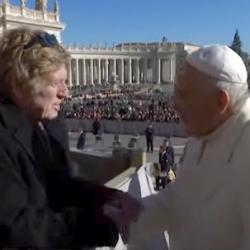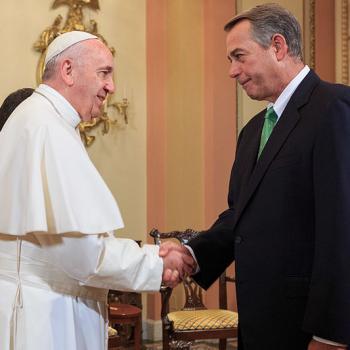You might think, from various excited postings around the Interwebs, that Pope Francis is about to name a woman cardinal.
Andrea Tornielli at Vatican Insider unpacks this notion:
The idea of appointing women to the College of Cardinals is not new…It was mentioned during the Synod of Bishops for Africa held on 10 October 1994, attended by John Paul II, when Mgr. Ernest Kombo, the Congo’s Jesuit bishop proposed the following: “Women must be able to rise to the highest positions in the establishment of the church, they should also be nominated as lay cardinals.” Shortly before this, the Anglican Church had ordained its first female priests in Westminster Abbey. John Paul II reacted to this by sending a long Apostolic Letter (the “Ordinatio sacerdotalis”) which stressed that it was impossible for the Catholic Church to ordain female priests…
…The cardinalate of course is an honorific title, not a Holy Order. The holder of the title of cardinal is a member of the clergy of the diocese of Rome and a collaborator and advisor of the Pope. Cardinals are expected to testify the faith usque ad sanguinis effusionem, meaning they must be ready to sacrifice their life for the faith. But Canon 351, paragraph 1, of the 1983 Code of Canon Law is also pretty clear on this: “The Roman Pontiff freely selects men to be promoted as cardinals, who have been ordained at least into the order of the presbyterate [i.e., priest] and are especially outstanding in doctrine, morals, piety, and prudence in action; those who are not yet bishops must receive Episcopal consecration.”
So “men” and “priests”. And once they are nominated, they must be ordained bishops. This law was introduced by John XXIII and meant that for centuries there were cardinals who were just priests or just deacons (the last cardinal deacon who was not a priest was Teodolfo Mertel, created cardinal in 1858 by Pius IX).
The Episcopacy rule still holds although under the pontificates of John Paul II and Benedict XVI, the Church started to do away with it in cases where an individual who was nominated cardinal asked to be exempted from Episcopal ordination due to their advanced age at the time of their nomination. Many theologians who were created cardinals after the age of 80 asked not to be made bishops, including the Jesuits Henri De Lubac, Avery Robert Dulles, Roberto Tucci and Albert Vanhoye
It is also worth remembering that a cardinal is by definition a member of the clergy. So being clericus – ordained that is – is not just a requirement of the Code of Canon Law but a constituent element of the cardinalate. When someone is created cardinal they become a member of the clergy of the diocese of Rome. It is this status that enables cardinals to vote for the Bishop of Rome.
Read more. Tornielli remains skeptical, noting something Francis had to say on the role of women:
“Mary, a woman, is more important than the bishops. I say this because we must not confuse the function with the dignity.”
This suggests that it is essential for women to be appreciated in the Church but not through “clericalisation”. It seems rather hasty to assume that Francis’ statements allude to the idea of the creation of female cardinals. It is not essential to dress women in red to ensure they are valued and given responsibilities in the Church.
Meantime, I would caution those who are using this particular news item as evidence of a sudden change about to occur to just take a deep breath. The item in El Pais getting so much attention mentions unnamed “observers” and suggests that Francis himself has thought about naming a woman cardinal—but it doesn’t explain how it knows that, or who is saying that, or give the notion any basis in fact. It quotes “one Jesuit priest” who says he wouldn’t be surprised if the pope made such a move. And that’s about it. Pretty flimsy sourcing.
It remains to be seen if this is just wishful thinking, or something more.
Meantime, for those pining for a lady in red, there’s this. Take it away, Chris De Burgh.

![cardinals1[1]](https://wp-media.patheos.com/blogs/sites/56/2013/09/cardinals11.jpg)










